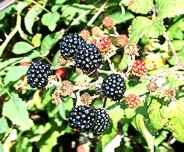

Blackberry (Rubus villosus, R alleghaniensis)
Folk Names: Bly, Bramble, Brambleberry, Bramble-Kite, Brameberry, Brombeere, Bumble-Kite, Brymbyl, Cloudberry, Dewberry, Fingerberry, Goutberry, High Blackberry, Scaldhead, Thimbleberry
Description: Blackberry is a member of the rose family. It is a trailing perennial, preferring dry, sandy soil. Though blackberries grow practically anywhere throughout the world, they grow most luxuriantly in Australian habitats. Opinions differ as to whether there is one blackberry with many aberrant forms or if there are many different species.
Blackberry propagates by seed and runners. The root survives for many years, sending up slender arches covered in sharp, recurved prickles. Each shoot grows alternates between growing one year and fruiting the next. The palmately compound leaves are up to eight inches long, and finely hairy. They are pinnate, with three to five ovate, doubly serrate leaflets. The upper leaves are sometimes simple and palmately lobed. White five-petal flowers appear from June to September, and the fruit is an aggregate of reddish-black drupelets maturing in mid to late summer. The fruit is differentiated from the raspberry by the thick core to which the drupelets adhere. In raspberries, the fruit detaches from the core when picked. Blackberries retain the core.
Effects: gentle
Planet: Venus Zodiac: Aries
Element: water
Associated Deities: Brigit
Traditions:
According to folklore, it is unlucky to eat or pick blackberries after October 11th. Other traditions say they must not be eaten after Michealmas, September 29th. This was due to a belief that after a certain time, the devil or a Puca would pass over the blackberries, making them unfit for consumption. Some said they had been spat upon, or that he had dragged his tail over the bush. Others said that he had merely waived his club over them. Of course, I dare anyone to find any blackberries left on the vine by October. If I donít pick as many as I can by the end of July, there arenít going to be any there for me at all.
While it was sacred to many European deities and used in their worship, it is mainly recalled as sacred to Brigit and was baked in pies on Lughnasadh (August 2) in honor of the harvest.
Magic:
A bramble forming a natural arch was often used for healing. On a sunny day, crawl through backward and forward three times, as nearly east to west as possible, for the treatment of boils, rheumatism, whooping cough, and even blackheads. A bramble arch could also cure lamed livestock. The young leaves were eaten in salad to relieve loose teeth, bleeding gums, and rheumatism. Chewing the leaves was also considered a treatment for snakebite, though I would assume the resultant paste was applied to the wound.
Dip nine leaves in spring water and lay them gently on an inflamed wound, burn, or scald, saying three times to each leaf:
Three ladies came from the east,(This is an invocation to Brigit)
One with fire and two with frost
Out with fire, in with frost
Leaves and blackberries were added to wealth spells.
The vines are protective when purposely grown, and may be gathered and woven into protective symbols or wreaths. Bramble may be gathered during a waning moon to ward off evil magic.
Known Combinations:
To treat dysentery, an old folk cure called for brambles, mugwort, and everlasting. Taking a bramble arch, which had both ends embedded in the earth, the healer was instructed to find the newer of the two roots, and cut it up into nine chips in the left hand. These were boiled in milk with the mugwort and everlasting. The milk was given to the sufferer to sip at over night.
Medical Indications: Parts Used : roots and leaves
Blackberry is an astringent and tonic. The berries are a good source of carbohydrates, iron, sodium, potassium, magnesium, and vitamin C. The leaves and roots have been used as a diarrhea remedy for centuries. Prolonged use of blackberry leaf tea has been suggested for enteritis, chronic appendicitis, and leucorrhoea. Tea from the dried root was used to treat dropsy. The Greeks used the berry as a treatment for gout.
Nutrition:
The fruit is used in jams, jellies, preserves, pies, and cakes. Young leaves are also edible, though not particularly appealing. Blackberry wine may be made by crushing the fruit and adding one quart of boiling water to each gallon of fruit. This is allowed to stand for twenty-four hours, stirring occasionally. Strain off the liquid and add two pounds of sugar to every gallon and keep corked until the following October. For a blackberry cordial, you can also press out the juice, adding two pounds of sugar to every quart along with a half ounce of nutmeg and cloves.
Mercantile Uses:
The young shoots mixed with alum make a light gray dye. The berries mixed with a mordant can create a rose, pink, or purple dye.